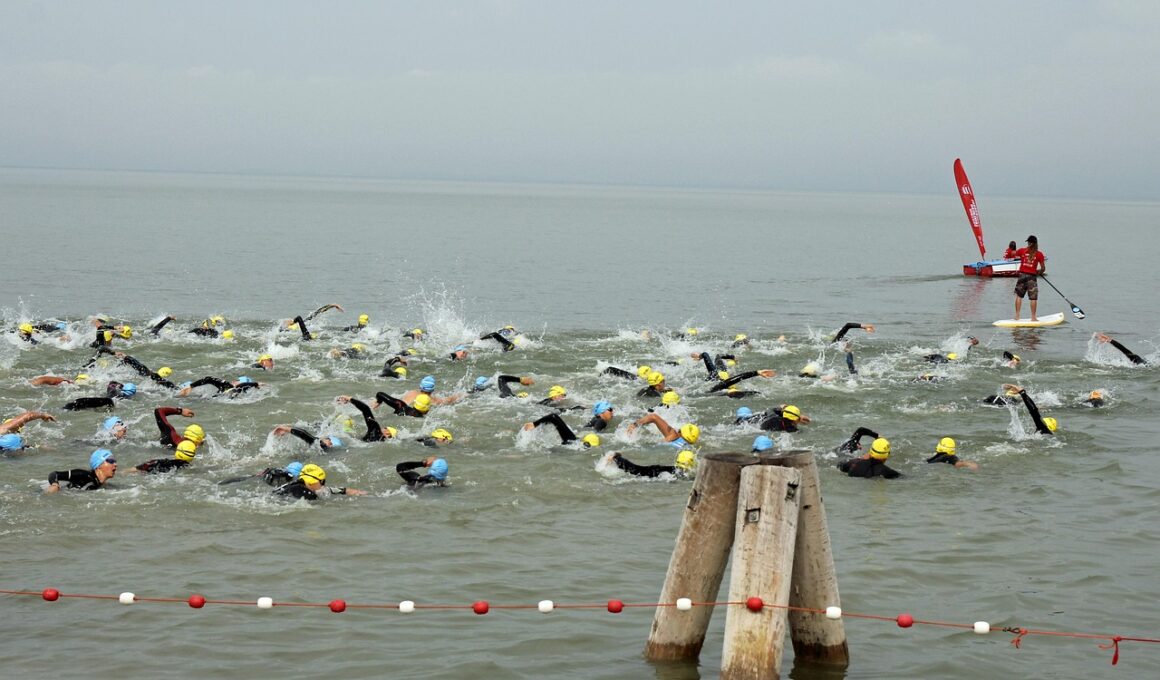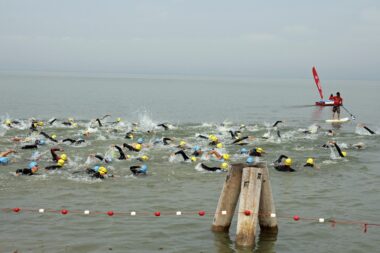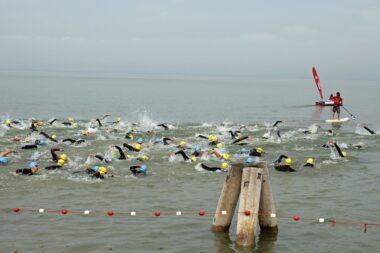How to Monitor Your Body’s Response During Cold Water Swimming
Cold water swimming offers unique challenges and benefits. Understanding how your body responds is essential for safety and enjoyment. Start by monitoring your heart rate before, during, and after swimming. Use a waterproof fitness tracker to record these changes. Heart rate variability can indicate stress levels and adaptation. Prioritize warm-up exercises to prepare your muscles and improve circulation prior to entering cold water. Ensure your body is acclimatized by gradually decreasing the temperature exposure. Additionally, mindfulness techniques can help, focusing your thoughts on breathing and body sensations. Recognize signs of hypothermia such as uncontrolled shivering, fatigue, and confusion. If you experience these symptoms, exit the water immediately. Drinking warm fluids post-swim aids in recovery, stabilizing your body temperature. Stretching can reduce soreness, enhancing overall performance. Consider keeping a swimming log to track your experiences and bodily responses. Your log should include water temperature, duration of swim, and any physical sensations felt during the activity. This personal data will help you refine your cold water swimming strategy and ensure that you enjoy the multiple benefits in a safe manner.
Understanding Temperature Effects on Your Body
Cold water can drastically affect your body’s thermoregulation mechanisms. When swimming in cold environments, your body diverts blood from the extremities to protect vital organs. This is known as vasoconstriction. It minimizes heat loss but can lead to numbness and reduced dexterity in your fingertips and toes. Be aware of the impact of water temperature. Research suggests that water temperatures below 15 degrees Celsius (59 degrees Fahrenheit) can increase the risk of hypothermia and make swimming uncomfortable. Look for local temperature resources and NOAA sites for updates before swimming. Dress appropriately by using a wetsuit, which provides insulation and prevents rapid heat loss. As you swim, constantly assess your comfort level; steer clear of pushing your limits too far. Having a swimming buddy can enhance safety and allow mutual monitoring of each other’s physical condition. Exit the water if discomfort becomes significant. A steady return to warm environments is crucial following exposure. Remember, a gradual transition from cold to warm conditions is vital for a smooth recovery. Always keep these considerations to foster an enjoyable cold water swimming experience while monitoring your body’s response to colder conditions.
Recognizing Signs of Cold Stress
Recognizing signs of cold stress is crucial for your safety while swimming. Your body will exhibit various symptoms indicating that it is struggling to maintain its core temperature. Shivering is often the first sign, indicating that your body is using energy to generate heat. However, as hypothermia sets in, shivering may decrease or stop altogether, which is a dangerous sign. Other symptoms include confusion, slurred speech, and impaired motor control. Behavioral cues are equally important; if you notice a lack of coordination or difficulty swimming, exit the water immediately. Sudden fatigue can also be a warning that your body is becoming overwhelmed by the cold. Keep an eye on your fingers and toes; if they become very cold or numb, it’s time to leave the water. Have a plan in place for emergencies, such as a friend on standby or quick access to warm, dry clothes. Staying alert to how your body feels can prevent serious consequences. Invest time in learning about cold stress symptoms to better protect yourself, ensuring you can enjoy cold water swimming safely.
During swimming, staying hydrated is as vital as monitoring your body temperature. Cold water immersion can mask feelings of thirst due to the initial shock and early responses. Therefore, drink fluids before and after your swim to maintain optimal hydration. Even if you don’t feel thirsty, consume water and electrolyte-rich beverages. These can offset the dehydration caused by the cold. While in the water, your body works hard to keep warm, which can lead to an increased metabolic rate, thus requiring more energy and hydration. Pay attention to the pace of your swimming and your breathing patterns; both can indicate your hydration needs. Taking breaks to hydrate in a warm environment is essential. Post-swim, replenishing lost nutrients can enhance recovery and improve performance in subsequent sessions. Tracking your hydration levels in your swimming log can also provide necessary insights, as frequent notes about how you felt can guide future swims. By prioritizing hydration along with temperature management, you set the stage for healthier swimming experiences and improve your overall endurance levels during cold water swimming.
Utilizing Recovery Techniques
Proper recovery techniques after cold water swimming can significantly improve your experience. After exiting the cold water, perform gentle movements to stimulate circulation without overwhelming your body. Dry off as soon as possible to prevent excessive heat loss. Wearing warm clothes and using blankets can help retain body heat. Gradually warming your body with hot drinks enhances recovery. While tea or hot chocolate is suitable, ensure they are not so hot as to cause burns. Incorporate stretching routines focusing on major muscle groups you used during the swim to prevent stiffness. If possible, utilize warm showers or baths to promote circulation. Elevating your legs can help reduce fatigue and swelling in the feet, especially if you’ve been in cold water for extended periods. Listening to your body as it adjusts back to regular temperatures is essential; pace your recovery routine based on how you feel. These recovery practices create a positive cycle, enabling better preparation for future cold water swims. Engage with the enjoyable aspects of swimming again by implementing a solid recovery strategy after every session outdoors in chilly waters.
Tracking your progress over time can enhance your cold water swimming experience significantly. Maintain a swimming journal where you log swims, condition notes, personal feelings and any pre-and post-swim rituals. Recording water temperatures can establish comprehensive data patterns indicating adaptation over time. Note any health changes, body responses, or adjustments in swim performance to spot trends. This feedback loop will optimize your swimming experience, adjusting your strategies as needed. Share your findings with other swimmers to exchange invaluable tips. Continual reflection on your experiences can lead to enhanced comfort levels while swimming in cold conditions. Use this journal not only as a training tool but also as a motivational resource, inspiring you to take on larger challenges in colder waters. Set specific goals like duration improvement, temperature acclimatization or overall comfort levels. As you progress and develop personal records, it reflects your growing experience and resilience, motivating continued engagement. Documenting these insights into your swimming routine can foster a closer connection with both the practice itself and with the body mechanisms responsive to cold water swimming.
Conclusion: Enhancing Your Experience
Ultimately, monitoring your body’s response while swimming in cold water is key to enjoying the activity fully. By being aware of physiological signals and adjusting your approach, you ensure both safety and pleasure in every swim. Remember to prioritize preparation, wearing appropriate gear and engaging in warm-up activities. Assess conditions before swimming, making reservations for emergency exits possible. Utilizing recovery techniques efficiently will help you bounce back after swims. Documenting experiences will guide effective adjustments for future swimming experiences, fostering continual improvement while ensuring enjoyment. Prioritize proper hydration before, during, and after swims to maintain physical well-being throughout your activities. Stay attentive to signs of cold stress; understanding their dangers can empower you to enjoy this invigorating activity without adverse effects. Recognizing personal limits and adapting accordingly can greatly influence overall success in cold water swimming. Identify your motivations for swimming in cold waters and set achievable goals that keep you engaged. By merging awareness and action, you can celebrate every victory, whether small or large. Join in and embrace the rejuvenating benefits of cold water swimming, while keeping your body’s response as a vital area of commitment.
Resource guides and swimmer communities can provide further insights and bolster support on your journey. Joining online forums, reading relevant blogs, and connecting with experienced cold water swimmers can serve as guidance. Engage with technologies that help in monitoring your body’s performance during swims. Opt for adjustable fitness trackers with temperature sensors to collect data actively while swimming. Many smart watches today come with extensive functionalities, including heart rate and oxygen monitoring. This type of technology can help determine safe limits for your swimming sessions. Taking advantage of local swimming classes or workshops can also enhance your capabilities. Speak to instructors to gain professional advice steadily. If possible, attend local swimming events or races to inspire motivation while connecting with like-minded individuals. Building a community around your swimming interest increases accountability and commitment, enhancing enjoyment and safety. Stay aware of evolving techniques or insights shared within such groups. Experiment with recommendations while being mindful of your unique response mechanisms. By remaining proactive and educating yourself, you will further enrich your cold water swimming experiences through an empowered understanding of your body.





